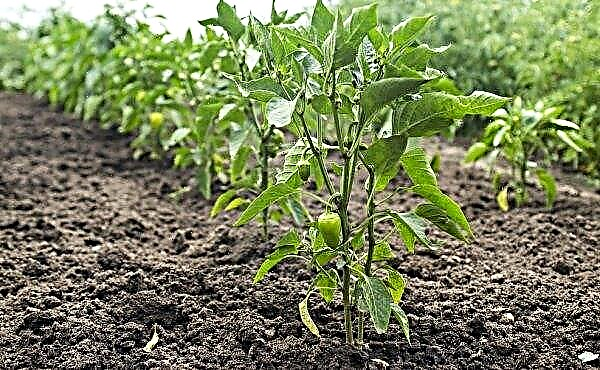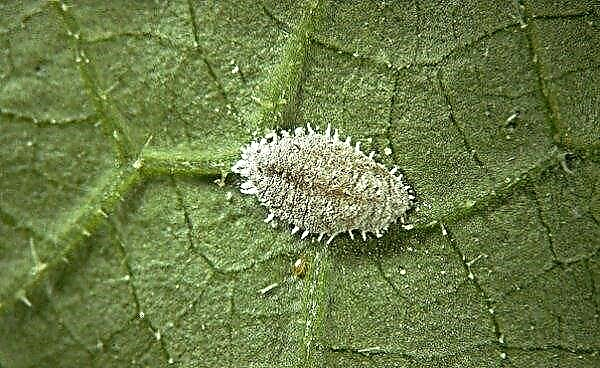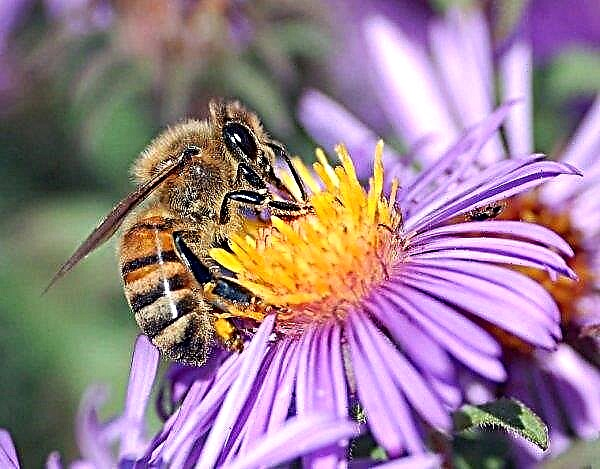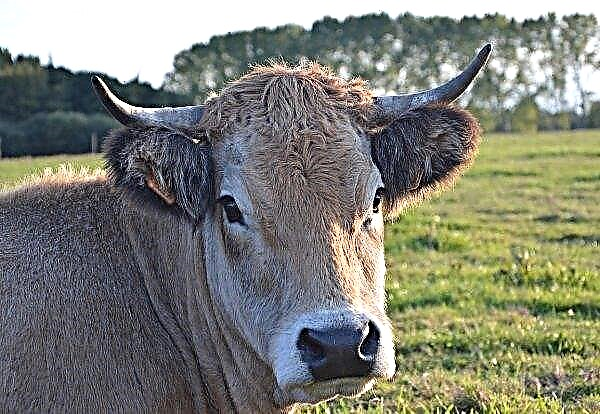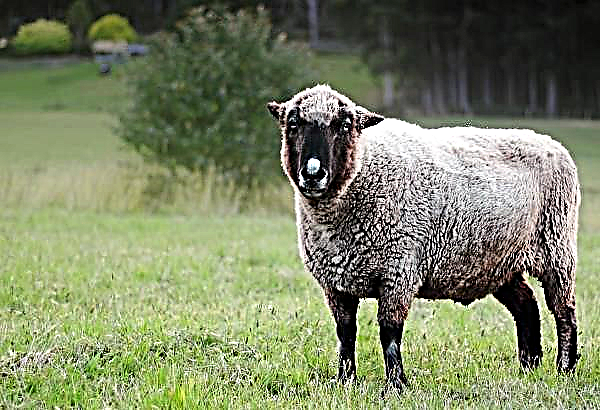If you are a lover of large, exotic and unpretentious plants in the apartment, then you will like cordilina. This flower harmoniously fits into any interior, grows well and does not cause trouble. From our article you will learn how to care for him.
Botanical description of the plant
Cordilin, some experts ranked as a family of agave, others as asparagus. Its name comes from the Greek word, which translates as "knot, bump", as the plant has knotty, pineal roots. The homeland of the cordilin plant are New Zealand and Australia. She is often confused with dracaena due to external resemblance. However, these plants belong to different genera. The flower has a high trunk, the bottom of which is exposed over time, and beautiful decorative leaves.
Did you know? Unlike most tropical plants, cordilin does not contain toxic substances. Therefore, it can be grown in homes where there are small children and pets.
The plant in appearance resembles a palm tree and has the following characteristic features:
| Root system | Fleshy, tuberous, thick, white |
| Stem length | Up to 1.5 m in residential conditions, up to 12 m in the wild |
| Leaf shape | Lanceolate, sword-shaped or linear |
| Leaf color | Green, meets red, light green, pink veins, stripes, spots |
| Inflorescence shape | In the form of a panicle, with small flowers |
| Flower color | Red, white, purple |
Types of cordiline
There are 26 species of cordilins, among which are trees, shrubs and shrubs.
In apartment conditions, these are often grown:
- Banks. Reaches a height of 1.5–3 m. The trunk is thin, straight. Green leaves, lanceolate, up to 1.5 m long and 8 cm wide, placed on long petioles. White flowers are formed in the panicle-shaped inflorescence.

- Apical. May have 1 thin or several trunks. The leaves are green with a reddish tint, with pronounced veins. It grows in length up to 50 cm, in width - up to 10 cm.

- Red It grows up to 4 m in height. The leaves are green, lanceolate, long and narrow. Their maximum length is 0.5 m, width is 5 cm. They grow on petioles 15 cm long. During flowering, an inflorescence is formed in the form of a panicle with pale blue flowers on short pedicels.

- Straight. It forms a thin trunk up to 3 m long. Lanceolate leaves, up to 0.5 m long and up to 3 cm wide. Inflorescences in the form of brooms. They are pale blue flowers.

- Inseparable. Tall species - in the wild it can reach 12 m. The trunk is thin and hard. The leaves are long, belt-shaped. Their length is 1.5 m, width is 15 cm. A red vein runs in the center of the dull green top sheet plate. The inflorescence is branched, drooping. The flowers are white in color.
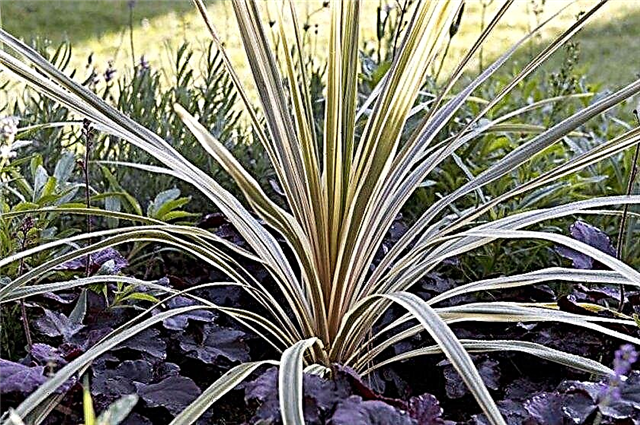
- South. Another tall look. The trunk is straight, expanded at the base. The leaves are long, in the form of swords. The colors are green with a central light vein. In the inflorescences are delicate white odorous flowers.

House growing conditions
For tropical and subtropical species, the living conditions are different. The common thing for them is a love of moderate humidity, good light, intolerance to temperature jumps and drafts.
Did you know? The local cordilina growing in New Zealand is used by locals for making ropes and fabrics, as well as for eating. Juice from the leaves is used to prevent and treat infections.
Lighting
The plant needs bright light, so it is placed in a bright place. In summer, the flower grows well at the window on the east or west side. In winter - from the south side. The sun's rays should not be direct, they must be scattered. Cordilins with dark leaves are able to maintain decorativeness in not too lighted corners of the house.
Ventilation
Temperature drops are harmful to cordilin. Therefore, when airing, make sure that drafts do not occur in the room. Their effect may adversely affect the decorativeness of the flower. If it is necessary to ventilate the room where the flower is contained, it is transferred to another room during the procedure.
Temperature mode
In the warm season, the plant develops at a temperature of +20 ... + 25 ° С, in winter - +5 ... + 10 ° С. For subtropical species, a decrease in temperature from autumn is carried out gradually. Tropical species love the warm ambient temperature. In winter, they need to organize the temperature regime at +18 ... + 20 ° С.
How to care at home?
Caring for cordilina will not cause much trouble. It needs to be regularly moistened, periodically fed, transplanted.
Important! Cordilina species that prefer tropical conditions and high humidity can be placed on a pallet with wet pebbles in the summer, wiped with a wet cloth and placed under a warm shower.
Watering
Cordilina has no special moisture requirements. It is watered in the same way as most houseplants, as the upper soil layer dries. Typically, the frequency of watering is 1-2 times a week in the summer and once every 7-10 days in the winter. In summer, you need to moisten more often, in winter - the frequency and volume of irrigation is reduced. Cordilin does not like overmoistening.
This is especially dangerous for those plants that are kept in winter at low temperatures. For irrigation use settled, rain or filtered water at room temperature. Using hard cold tap water is detrimental to the plant. It is advisable to pour water into the pan.
Spraying
Subtropical species need to be sprayed rarely - they are not picky about the level of air humidity. Tropical species are sprayed daily from late spring to late summer. For spraying, as for irrigation, use warm, settled water.
Top dressing
In order to achieve good plant growth and maximum decorativeness, it is necessary to fertilize it regularly. As top dressing, purchased universal universal fertilizers developed for deciduous crops are used. They are made weekly from spring to autumn. In the cold season, the number of top dressings is reduced to 1 time per month. Species that are transferred to the cold in winter do not need to be fed.
Pruning
Pruning to form a cordiline crown is not required. Need to remove damaged, old, dried leaves. Use sharp scissors to trim the shrunken ends of the leaves. Trimming the stem can be done in case of stretching the plant. It is cut to a height of 10 cm from the base, above the old leaf knot. In the future, shoots will appear on it. Trimming work is done in the spring.
Important! The soil purchased in the store does not require pre-treatment before planting. The substrate made by hand must be disinfected - calcined in the oven or sprinkled with a solution of potassium permanganate (1%).
Transfer
Young plants need an annual transplant. Mature - 1 time in 2-3 years. The transplant is carried out in the spring, preferably in March. A container is selected in size (for a plant 40–45 cm high, a pot of 15–20 cm across is needed), they buy or make a substrate with their own hands. In terms of acidity, the soil should be slightly acidic, with a pH level of 6–6.5.
You will need to mix these components:
- garden land (3 parts);
- sand (1 part);
- peat (1 part).

Transplant Technology:
- It is good to water a flower.
- Remove along with an earthen lump from the container in which it grows.
- Gently peel the roots from the ground.
- At the bottom of the pot lay a drainage layer - expanded clay, pebbles.
- Top with a layer of soil mixture.
- Set the flower in the center.
- Cover the roots with earth.
- Water abundantly.
- Put in a room with a temperature of +20 ... + 22 ° С.
Breeding
Propagate the flower in 3 ways:
- Dividing the rhizome.
- Cuttings.
- The seeds.
Division
The division of rhizomes is as follows:
- To water the soil.
- Extract the plant from the pot.
- Clear of an earthen coma.
- Rinse the roots.
- Separate part of the rhizome and cut off all the roots from it.
- Cut the rhizome into several parts.
- Place all parts for rooting in a light substrate.
- Cover the pot with a bag.
- Regularly ventilate and moisturize.
- After rooting, about a month later, plant in a permanent place.

Cuttings
It is better to separate the cuttings in the spring.
Do it like this:
- Semi-lignified apical or middle shoots are cut.
- They are divided into parts so that 1-4 nodes remain in each.
- Cuttings are placed in water or planted in a moist substrate for rooting.
- A container with cuttings is placed in a room with a temperature of +25 ... + 30 ° C. You can create a mini-greenhouse by covering it with a bottle of plastic, polyethylene or glass packaging.
- If necessary, add water, moisten the substrate.
- After root formation (about 30 days later), the plant is planted in a permanent place.
Video: propagation of cordilina by cuttings
Seeds
The seed method for the propagation of cordilina at home is not used. This process is troublesome and long. It is used only for natural species. As a rule, when sowing seeds germinate sparsely. Sprouts appear within 1-3 months.
Growing difficulties
When growing plants, you may encounter the following problems:
- Light spots on the foliage. The reason lies in the excess of sunlight. Move the pot to a shaded place or cover the flower from the sun.

- Drying and browning of the tips of the leaves. There may be several reasons why the leaves of cordilina dry. One of them is dry air indoors. Another is insufficient moisture. You need to regularly spray the plant and establish a watering regime.

- Brown spots on the leaves. One reason for the development of the problem is a lack of moisture. To eliminate the need for regular hydration.
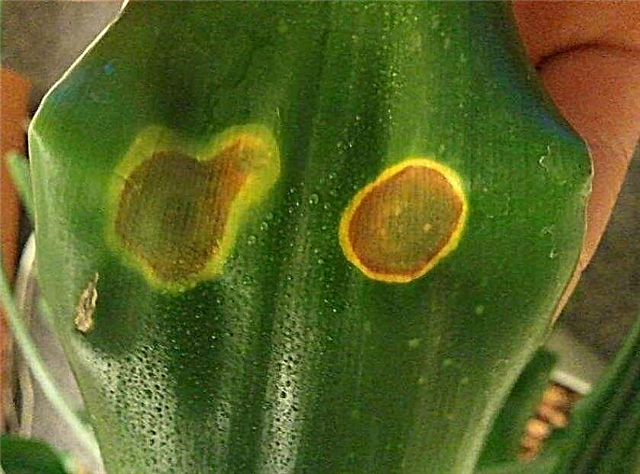
- Rotting of the stem from below. This is due to waterlogging. It is necessary to stop watering and establish their correct mode. The plant needs to be transplanted into new soil, carefully inspecting the roots and pruning the affected areas.

- Leaf fall of lower leaves. Leaves from the lower tier will fall constantly - this is a natural process. However, if the leaf fall is strong, then you need to pay attention to the location of the cordilina pot. Perhaps she lacks light and needs to be placed in a brighter place.
- Curl and soften the leaves. Most likely, in this way the plant reacts to the cold. It is necessary to increase the temperature in the room or rearrange it in warmer conditions.
- Yellowing foliage. It occurs for two reasons: lack of nutrients and low air humidity. It is necessary to start spraying the plant and fertilizing it.

Also, if the florist mistakes during planting or care, the flower may become ill or be invaded by harmful insects.
Disease
Of the diseases more often root rot. Signs of the disease: unhealthy appearance of the plant, stunting, drying out of the leaves. The factors that provoke the disease are excessive watering and cold. Treatment consists of trimming diseased roots, washing healthy roots with hot water, treating the cut sites with activated charcoal, fungicide, which is allowed for indoor plants. After drying for a day, the plant is transplanted into a new pot and soil. With strong rotting of the roots, the top of the plant is cut off, rooted and planted in a new container and soil.
Pests
On cordilin can settle:
- Mealybug. It leaves a characteristic symptom - white loose discharge, similar to cotton wool. They struggle with it by rubbing with a soap solution, spraying with a solution of green soap, infusions of tobacco, garlic, a decoction of cyclamen, tincture of calendula, alcohol, drugs “Aktara”, “Biotlin”, “Calypso”, “Confidor”, “Fitoverm”.

- Spider mite. The presence of a web on spines and stems, as well as small red dots, will tell you that the plant was chosen by a tick. This parasite loves heat and dryness. To get rid of it, you need to wipe the flower with a soapy solution. In case of severe infection, treatment is needed funds Fitoverm, Bi-58, Karate, Iskra-M, Actellik.
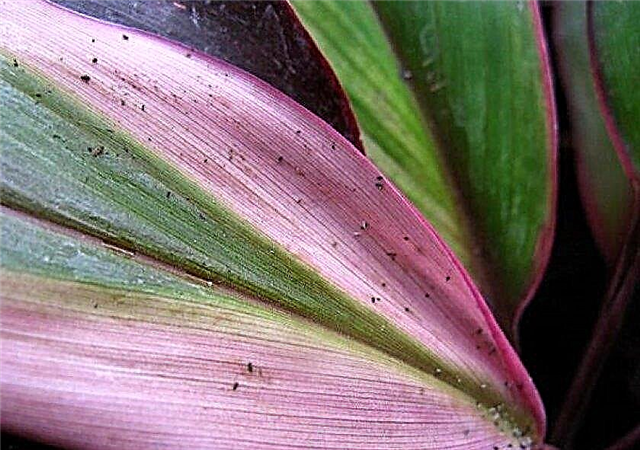
- Shield. It is easy to notice. This small insect is covered with a hard shell. It feeds on flower juices. The first symptoms of the appearance of the scale are sticky fluid on the trunk. Destroy it mechanically - scraping with a brush. Acetic wipes are also effective, rubbing with tincture of garlic, red pepper. With severe infection, they resort to chemical treatment using “Fitoverm”, “Actellik”, “Metaphos”.

- Whitefly Moths with white wings. The danger is not butterflies, but their larvae that feed on leaves. As a result, they turn yellow and curl. To combat whitefly, the above insecticides are used. Soap solution, tobacco and dandelion infusions also help scare away the insect.

Signs and superstitions
The people will take a little and superstitions associated with cordilina, the plant is considered positive. It is called the tree of fortune. It is believed that in the house it should be placed in a corner - living in such conditions, it activates Chi energy, has a beneficial effect on the creative abilities of households and helps maintain harmony in relationships and a favorable aura in the house.
Cordilina is an exotic plant resembling a palm tree. Despite its large size, a beginner in flower business can also cope with the cultivation of plants. The flower will decorate the apartment, office, greenhouse, conservatory.
















